Sundha hill Inscription of Chachigadeva
| Author:Laxman Burdak, IFS (R) |
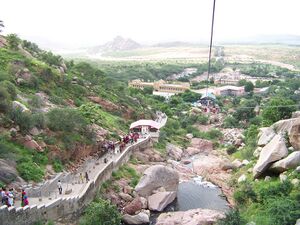
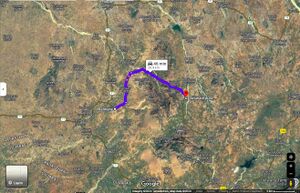
Sundha hill Inscription of Chachigadeva of V.S.1319 (A.D. 1262), the Chauhan ruler of Jalore, was found on the Sundha Hill, a site of Sundhamata Temple in Bhinmal tehsil of Jalore district situated in the mid-east of Malwara to Jaswantpura Road near Dantlawas village.
C. Sunda hill Inscription of Chachigadeva of V.S.1319 (A.D. 1262)
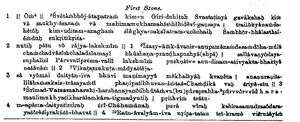
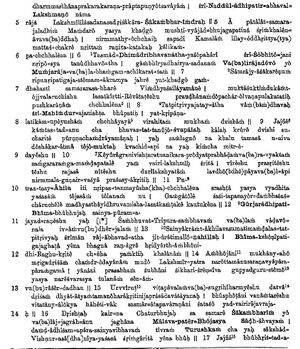
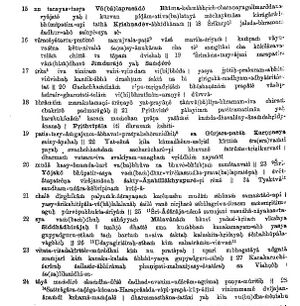
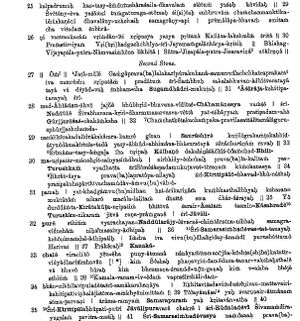
Reference - Epigraphia Indica Vol.IX By Kielhorn, pp.70-83 Sunda hill Inscription of Chachigadeva of V.S.1319 (A.D. 1262) was found on the Sunda Hill, about 10 miles north of Jashwantpura in the Jaswantapura district of the Jodhpur State of Rajasthan. Jaswantpura (जसवंतपुरा) is a town in Bilada tahsil of Jodhpur district in Rajasthan.
Location
[Page-70] This inscription is on two stones which -were found on the Sunda Hill, about 10 miles north of Jashwantpura in the Jaswantapura district of the Jodhpur State of Rajasthan. I edit it from rubbings, kindly placed at my disposal by Mr. Gaurishankar Hirachand Ojha.
Details
The first stone contains 26 lines of writing -which covers a space of 3' 3" broad by 1' 7-1/2" high, the second 24 lines which cover a space of 2' 10" broad by 1' 5" high. The inscription was carefully written by Nāmvasimha, a son of the physician Vijayapala, and well engraved by Jisaravi, a son of the sutradhāra Jisapala, and is in a state of perfect preservation. The characters are Nagari, and the language is Sanskrit. Excepting two prose passages at the bottom of either stone which record the names of the author, the writer and the engraver, the date samvat 1319 in line 48, and another prose passage, numbered as a verse, in lines 35 and 36, the text is in verse, the total number of verses (including, the prose passage counted as a verse) being 59. As regards orthography, the sign for v denotes both v and b. The language is generally correct and plain, but there are one or two passages about the exact meaning of which I am still doubtful. I especially do not understand verse 12, which seems to allude to some legend unknown to me, in which the creator weighs the sun and the moon, apparently using the Ganges as a balance.
Moreover, I am not sure about the meanings of the word Shrikari (Kari ?), which occurs in verses 19 and 59, and gupyadguru in verses 15, 26, and 27. To judge from the context in verse 59 (Shrikari-sapta kavādi-), the former 9 may denote some kind of musical instrument and as a gupyadguru must be
Page-71 - something on which a golden kumbha and a golden kalasa can be placed, the word perhaps denotes a temple generally or a particular temple. Of rare words or words employed in an unusual way we may note keli, 'the earth,' in verse 6, bhusphoṭa, ' a mushroom,' in verse 16, the feminine yugali, 'a pair,' in verse 18, and tāmbuliya, ' an areca-nut,' in verse 21 ; bandhu and bandhava denote ' a brother' in verses 24, 26, and 20 ; and a cousin is described as pitrivyajatayā bandhava, i.e. ' a brother in consequence of being born from a paternal uncle,' in verse 9.
The inscription in the prose passage at the bottom of the first stone and in verse 59 is styled a prshasti. It was composed by the (Jaina) suri Jayamangala (Jayamangalacharya), who belonged to the Brihad-gachchha and was a disciple of Ramachandra, himself a disciple of Devacharya.
And its primary object is to glorify the Chahamana chief Chachiigadeva, during whose reign it was composed, and for whom it furnishes a date in the month of Vaisakha of the [Vikrama] year 1310, falling in about A.D. 1262. Fortunately, the author has used the occasion to give a eulogistic account of the Chahamanas of Naddula generally, which is of considerable interest.
Verse wise interpretation
Verses 1-3 pray the moon on Sambhu's (i.e. Siva's) forehead and (Siva's consort) Parvati or Chandika to grant continuous good fortune and happiness. Verse 4 -then records that formerly there was the hero Chahamana, a source of joy to the great Rishi Vatsa. In his lineage there were :
- (1.) The lord of Naddula, king Lakshmana, who was a Sakambhari prince (vv. 5 and 6).
- (2.) His son Sobhita (v. 7; the Sohiya and Sobhita of A. and B.). He took away the glory of the lord (or lords) of the mountain Arbuda. 6
- (3.) His son Baliraja (vv. 7 and 8). He defeated an army of Munjaraja, i.e. the Paramara Vakpatiraja II. Amoghavarsha of Malava, for whom we possess dates from A.D. 974 to 993.
- (4.) His paternal uncle's son Mahindu (v. 9). He is the Mahendra of A. and B., the son of Vigrahapala whose name is here omitted. He most probably is identical with the Mahendra or Mahindra (?) mentioned under No. 53 of my Northern list as a contemporary of the Rashtrakuta Dhavala of Hastikundi, whose inscription is dated in A.D. 997.
- (5.) His son Asvapala (vv. 10 and 11 ; omitted in A. and B.).
- (6.) His son Ahila (vv. 12 and 13 ; likewise omitted in A. and B.). He defeated an army of the Gurjara king Bhima, i.e. the Chaulukya Bhimadeva I, of Anahilapataka.
- (7.) His paternal uncle Anahilla (vv. 14-17 ; in A. and B. described as the son of Mahendra). He also defeated the king Bhima (Bhimadeva I.) ; took Sakambhari ; and slew
- [Page-72] (or defeated) Sādha, a general of the Malava king Bhoja (i.e. the Paramara Bhojadeva), and the Turushka.
- (8.) His son Bālaprasāda (vv. 18 and 19; omitted in B.). He forced the king Bhima (Bhimadeva I.) to release from prison a king named Krishnadeva. This Krishuadeva most probably is the Paramara Krishnaraja (the son of Dhandhuka and grandson of (?) Devarāja), of whom we have two inscriptions at Bhinmal (Srimala), dated in A.D. 1060 and 1067 (Nos. 689 and 690 of my Northern List).
- (9.) His brother Jinduraja (vv. 20 and 21; the Jendrarāja of A. and B.). He fought victoriously at Saṇndḍera (the modern Sanderao in the Jodhpur State, south-west of Nadol).
- (10.) His son Prithvipala (vv. 22 and 23 ; omitted in B.). He defeated an army of the Gurjara king Karna, -i.e. Bhimadeva's son and successor Karna Trailokyamalla.
- (11.) His brother Yojaka (vv. 24 and 25 ; the Jojalla of A., omitted in B.). He by force occupied Anahillapura (Anahilapataka).
- (12.) His brother Āśārāja (vv. 26-30 ; in B. described as the son of Jendrarāja). He pleased Siddhadhiraja, i.e. Karna' s son and successor Jayasimha Siddharaja, by the assistance which he rendered to him in the country of Malava, but afterwards apparently was on hostile terms with him. With the account of Asaraja ends that part of the inscription which is on the first stone. The part on the second stone (after a symbol for Om) begins, as if it were an independent inscription, with a verse (v. 31) praying for the blessing of Sambhu (Siva), ' the crest of the Sugandhadri i.e. the mountain, Sugandha, which clearly is the Sundha Hill where the inscription was found.
The author then continues the genealogy by stating that Asārāja'a son was -
- (13.) Ahlādana (vv. 32 and 33 ; the Alhanadeva of A. and B.), His assistance was sought by the Gurjara King, and his army put down disturbances in the mountainous part of Surashtra (girau Saurāshtri). He built a Siva temple at Naddula. We have seen above that the two inscriptions A. and B., which are of this chief's reign, are dated in A.D. 1161 and 1160. Before that time, he is mentioned (together with his son Kelhana), apparently as a feudatory of the Chaulukya Kumarapala, in the Keradu fragmentary inscription of Kumarapala's reign which is dated in A.D. 1153 (No. 183 of my Northern List).
- (14.) His son Kelhana (v. 34). He defeated the southern king Bhilima, and after destroying the Turushka erected a golden torana, ' like a diadem for the abode of the holy Somesa.' For the Mahārājādhiraja Kelhana I have given above, p. 68, note 1, a date i.e. A.D. 1165. The southern king Bhilima, whom he is said to have defeated, must have been the Devagiri-Yadava Bhillama, whose Gadag inscription is dated in A.D. 1191 (No. 334 of my southern List).
- (15.) His brother Kirtipala (vv. 35 and 36). He defeated a Kirātakuta chief named Asala, and at Kasahrada routed an army of the Turushka. As ruler of the kingdom of Naddula he took up his residence at Javalipura. Of the places here mentioned Kirātakuta is Kiradu, according to, Bhavnagar Inscr. p. 172, 3 'a small village near Hathamo under Barmer'. Javalipura, to which Kirtipala transferred his residence, is the
- [Page-73] town of Jalor in the same State. A place named Kasahrada has been identified by the late Prof. Buhler with Kasandra or Kasandhra, a village with about 400 inhabitants on the road from Dholka to Palitana,in Long. 72-11', Lat. 22- 19'; but the Kasahrada of this inscription may be a different place nearer Nadol. According to verse 41 Kirtipala's daughter Rudaladevi built two temples of Siva at Javalipura.
- (16.) His son Samarasimha (vv. 37-40). He built extensive ramparts on the Kanakāchala (or 'gold hill') and founded the town of Samarapura. This town I am unable to identify. Kanakāchala according to Mr. Ojha is the name of the fort of Jalor which, he informs me, is locally known as 'Sonalgarh,' and the Sauvarna-giri of Javalipura I find actually mentioned in an inscription on Mount Abu. In an inscription of the [Vikrama] year 1221, from which Mr. Ojha has sent me a quotation, it is called Kānchana-gadha. Samarasimha clearly is the Chāhu[māna]-rāna[ka]--Samarasiha, whose daughter Liadevi was the (or a) queen of the Chaulukya Bhimadeva II.
- (17.) His son Udayasimha (vv. 42-46). According to the prose passage in lines 35 and 36 he ruled 'the glorious Naddula, the glorious Javalipura, Madavyapura, Vagbhatameru, Surāchanḍa, Rāṭahrada, Kheḍa, Rāmasainya, Shrimala, Ratnapura, Satyapura, and other places.' With the exception of Mandavyapura and Ratahrada the places here enumerated are easily found on the map of the Rajputana Agency (in Marwar) under the names Nadol, Jalor, Barmer, Surachand, Kher (between Tilwara and Balotra), Ramsen, Bhinmal, Ratanpura and Sanchor. Mandavyapura is Mandor, according to the Rājputāna Gazetteer three miles from Jodhpur ; Ratahrada (?) I cannot identify. (Note: Radadhara in Malani, Barmer) Udayasimha's queen was Prahlādanadevi, who bore to him two sons Chāchigadeva and Chamundaraja. Regarding his exploits, the inscription states in a general way that he curbed the pride of the Turushka, was not to be conquered by the Gurjara kings, and put an end to the Sindhu king. He was a scholar conversant with the great works of Bharata and others, and built two Siva temples at Juvalipura. Udayasimha clearly is identical with the Mahāraja-dhirāja Udayasimhadeva of whose reign we have three inscriptions at Bhinmal (Nos. 697-699 of my Northern List) dated in the [Vikrama] years 1262, 1274 and 1305, corresponding to about A.D. 1205, A.D. 1218, and about A.D. 1248 ; and also with the Mahārājakula Udayasimhadeva, for whom I have given a date, falling in A.D. 1249, in Ind. Ant. āol. XIX. p. 175, No. 115. He was succeeded by-
- (18.) His son Chachigadeva (vv. 47-57). He in verse 50 is described as 'destroying the roaring Gurjara lord Virama, hating the enemy Salya, taking exquisite delight in felling the shaking (or leaping) Pātuka, depriving of his colour Sanga, and a thunderbolt to the mountain the furious Nahara. As will be seen from this translation, the words Salya, Pātuka and Sanga, of the original must in, my opinion, like Virama and Nahara', be taken as proper names ; but of the five persons enumerated I can identify only the first. Being described as 'Gurjara lord, Virama appears clearly to be the Vaghela Viramadeva, the son of Viradhavala and elder brother of Visaladeva, who is reported to have been the son-in-law of Udayasimha of Javalipura, and
- [Page-74] would therefore have been the own brother-in-law of Chachigadeva. The following verses treat of the same chief's works of piety. At Srimāla he remitted certain taxes, and at Ramasainya he granted funds for the worship of (the god) Vigrahaditya, and placed a golden cupola (kumbha) and a flag-staff (dhvaja) on the temple of (the god) Aparajitesa to whom at the same time he gave a silver girdle (mekhalā). For the same temple he provided a hall (shāla) with a car (ratha) richly decked with precious stones. Chachigadeva visited the Sugandhadri, worshipped there the goddess Chamunda, known by the name Aghaṭesvari, and at her temple established a mandapa which was consecrated by the Brāhmans on the akshaya-tritiyā of the month Vaisakha of the [Vikrama] year 1319.
I have already stated that the inscription thus for the reign of Chachigadeva yields a date in about A.D. 1262. Two other dates, of She [Vikrama] years 1333 and 1334, falling in about A.D. 1276 and 1277, are furnished for him by the two Bhinmal inscriptions Nos. 702 and 703 of my Northern List, where he is described as the Maharājakula Chachiga or Chachigadeva.
I may add that Chachigadeva is mentioned, under the name Chacha, in line 8 of the Jodhpur inscription of Rupadevi, published by me above, VoL IV. p. 312 ff. In my text of that inscription I have given the name as Chāva, and a renewed examination of the impressions enables me to affirm that either this is the actual reading, or that at any rate the name would be so read in the impressions by any one not acquainted with what we have learnt now from the Sundha Hill inscription. Knowing what I do now, I have no doubt that the intended reading IB Chacha. This Chacha is called a Chahamana in Bupadevi's inscription and described as the son of Udayasimha and grandson of Samarasimha, which exactly fits our Chachigadeva. The inscription supplies the additional information that Chacha's wife was Lakshmidevi, and that this lady bore to him Rupadevi, who became the wife of a king Tejasimha (to whom she bore a son named Kshetrasimha) and founded a well or tank in A.D. 1284, in the reign of the Maharājakula Samyantasimhadeva.
[Page-80] Then there came Lakshmana, who by his irresistible valour acquired part of the earth.' In the mutilated verse 12, which together -with verse 11 treats of this chief, the word Naddula is distinctly legible, as well as Shakambhari; and it is certain that Lakshmana is described in the verse as king of Naddula, and highly probable that he is spoken of as Shakambharimāṇikya, 'the jewel of Sakambhari.' After him, verse 13 mentions 'his son' Baliraja, and Baliraja's ' son,' whose name I read as Sohi, regarding this to be another form of the name Sohiya (Sobhita, Shobhita,) of the preceding inscriptions. According to the latter, Sohiya was Lakshmana's son, and his son again -was Baliraja ; the author of the present inscription has erroneously transposed the two names. Verses 14-18 then enumerate Mahindu, Jinduraja, Asarja, Alhana, Kirtipala and Samarasimha. From what we know already from the other inscriptions, this is the line, from father to son, of the Chahamanas of Naddula from Mahindu to Samarasimha, except that, between Mahindu and Jinduraja, Anahilla, the son of the former and father of the latter, has been omitted. So far our inscription tells us nothing of importance that is new.
Samarasimha, according to verse 19, had two sons, of whom the one called Udayasimha, who also is already known to us from bhe inscription C., succeeded him in the government, Udayasimha's elder brother was Mānavasimha (v. 20) ; his son was Pratāpa (v. 21), and his son Vijaḍa, also named Daśasyandana (v. 22). This chief married Nāmalladevi (v. 23), who bore to him four sons Lāvanyakarna, Lundha, Lakshmana, and Luṇavarman (v. 24), of whom the eldest became the ruling chief. When Lavanyakarna died, he was succeeded by the next brother, whose name in verse 26 ia clearly Luṇtigadeva, in verse 28 Luntiga, in verse 30 Luṇḍāgara, and in the prose passage in line 29 Lunṭagara. Luntiga conquered and ruled all countries, particularly Chandravati and the divine territory of Arbuda (Arbuda-divya-desam, v. 27). On the mountain Arbuda he set up images of himself and his queen, and carried out repairs at the temple of Achaleshvara. As a grant to the temple, he moreover gave the village of Heṭhñji fl (v. 33) for the perpetual worship of the god.
Period
From the prose passage which follows, and which is more or less illegible, we learn that in the year 1377, on Monday, the 8th of the bright half of Vaisakha, in, the Kshaya-Samvatsara, Luntiga, described as the Mahārājakula, the glorious Luntagara, resided at [Vu ?]huṇḍha which belonged to Chandravati. This date regularly corresponds, for the expired Kārttikādi
[Page-81] Vikrama year 1377, to Monday, the 6th April A.D. 1321, when the 8th tithi of the bright half of Vaishakha ended 17 h. 13 m. after mean sunrise j the day did fall in the Jovian year Kshaya, which according to the northern mean-sign system lasted from the 30th May A.D. 1320 to the 26th May A.D. 1321.
Localities mentioned
Of the localities mentioned, in addition to the well-known Arbuda or Mount Abu, Chandravati according to the Rajputana Gazetteer, Vol. HE. p. 126, is a large place (now in ruins) on the Banas river near the south-east border of the Sirohi State. There can be no doubt that it was taken by Luntiga from -the Paramaras. Hethunji is the small village of Hetamji on Mount Abu. Vuhundha (?) if this is really the name I am unable to identify.
On Mount Abu there are at least two other inscriptions, of no great extent and partly illegible, of the reign of Luntigadeva, described as the Mahārjākula, the glorious Lundhaka Lundha(?). One is dated on Wednesday, the 8th of the dark half of chaitra in the (Vikrama] year 1372, corresponding, so far as I can see, to Wednesday, the 17th. March A.D, 1316 ; the other on some specified day, which I cannot make out with certainty, in the [Vikrama] year 1373. And there is a third, partly effaced inscription, which also mentions the Mahārājakula, the glorious Lundhaka or Lundhaka, and speaks of the glorious Nāmaladevi, who clearly is the Namalladevi of the present inscription, the mother of Luntigadeva, I am not at present prepared to give a fuller account of these three inscriptions.
Account from other Inscriptions
But I may add here that another account of some of the later Chahamanas is found in an inscription, which is on a stone at a temple the Vimala-vasahikā, ordinarily but wrongly called Vimala Sah's or Shah's temple which was founded on Mount Abu, according to the inscription itself in the Vikrama year 1088, by a certain Vimala, ' an ornament of the Pragvata race,' after he had been appointed dandapati at Arbuda by the (Chaulukya) king Bhimadeva (I.). This inscription in lines 9-15 (verses 14-22) gives the following rājdvali :
There was a hero, Asaraja by name, a moon to the lotus-flower the Chahuvāma family, who was king of the town of Nadulla (v, 14). Then there came Samarasimaha ; and his son was Mahanasimhabhata (v. 15). Then came Pratapamalla ; and of him was born Viada, who ruled the Marusthali-mandala (v. 16). He had three sons, the first of whom was the king Luniga (v. 17). After him the text mentions Lundha (v. 18) and Lumbha (v, 19), without distinctly saying that they were his younger brothers; It then records the conquest Of Arbuda (v. 20) ; says further that Luniga's son was Tejasimha (v. 21) ; and after him eulogizes Tihuṇaka, to whom it wishes long life (v. 22).
The mutilated verse 23 appears to say that the glorious Lumbhaka, together with Tejasimha and Tihuna, in right manner carried on the government of the mountain Arbuda;
References
Back to List of Inscriptions

